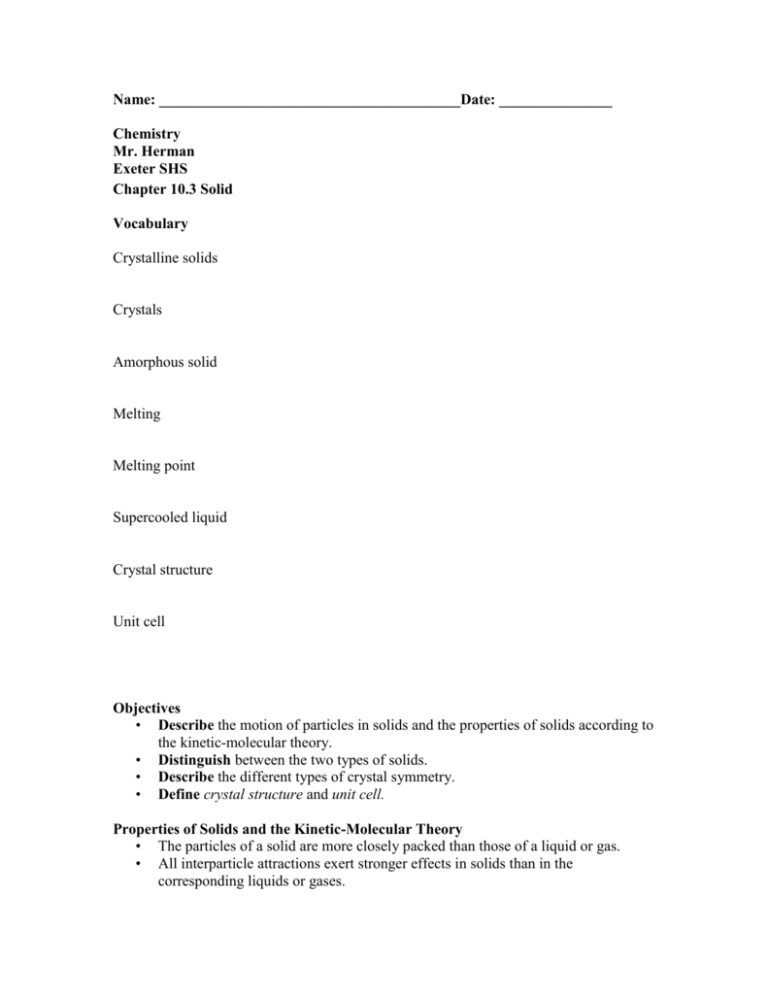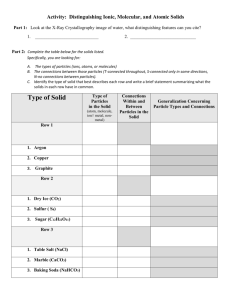Section 10.3 Solids
advertisement

Name: ________________________________________Date: _______________ Chemistry Mr. Herman Exeter SHS Chapter 10.3 Solid Vocabulary Crystalline solids Crystals Amorphous solid Melting Melting point Supercooled liquid Crystal structure Unit cell Objectives • Describe the motion of particles in solids and the properties of solids according to the kinetic-molecular theory. • Distinguish between the two types of solids. • Describe the different types of crystal symmetry. • Define crystal structure and unit cell. Properties of Solids and the Kinetic-Molecular Theory • The particles of a solid are more closely packed than those of a liquid or gas. • All interparticle attractions exert stronger effects in solids than in the corresponding liquids or gases. • Attractive forces tend to hold the particles of a solid in relatively fixed positions. • Solids are more ordered than liquids and are much more ordered than gases. Two Types of Solids • There are two types of solids: crystalline solids and amorphous solids. • Most solids are crystalline solids—they consist of crystals. • A crystal is a substance in which the particles are arranged in an orderly, geometric, repeating pattern. • An amorphous solid is one in which the particles are arranged randomly. Definite Shape and Volume • Solids can maintain a definite shape without a container. • Crystalline solids are geometrically regular. • The volume of a solid changes only slightly with a change in temperature or pressure. • Solids have definite volume because their particles are packed closely together. Definite Melting Point • Melting is the physical change of a solid to a liquid by the addition of energy as heat. • The temperature at which a solid becomes a liquid is its melting point. • At this temperature, the kinetic energies of the particles within the solid overcome the attractive forces holding them together. • Amorphous solids have no definite melting point. • example: glass and plastics • Amorphous solids are sometimes classified as supercooled liquids, which are substances that retain certain liquid properties even at temperatures at which they appear to be solid. • These properties exist because the particles in amorphous solids are arranged randomly. High Density and Incompressibility • In general, substances are most dense in the solid state. • The higher density results from the fact that the particles of a solid are more closely packed than those of a liquid or a gas. • For practical purposes, solids can be considered incompressible. Low Rate of Diffusion • The rate of diffusion is millions of times slower in solids than in liquids Crystalline Solids • Crystalline solids exist either as single crystals or as groups of crystals fused together. • The total three-dimensional arrangement of particles of a crystal is called a crystal structure. • • • The arrangement of particles in the crystal can be represented by a coordinate system called a lattice. The smallest portion of a crystal lattice that shows the three-dimensional pattern of the entire lattice is called a unit cell. A crystal and its unit cells can have any one of seven types of symmetry. Binding Forces in Crystals • Crystal structures can also be described in terms of the types of particles in them and the types of chemical bonding between the particles. Melting and Boiling Points of Representative Crystaline Solids






